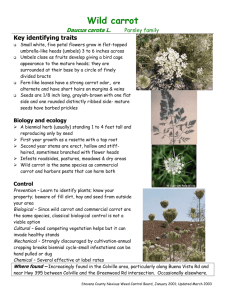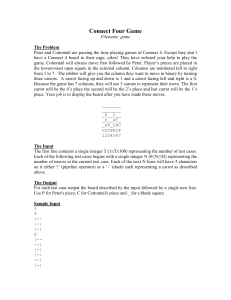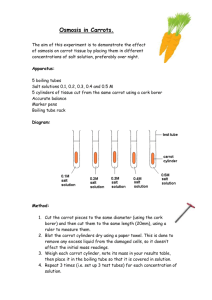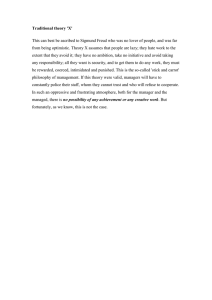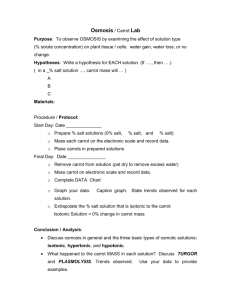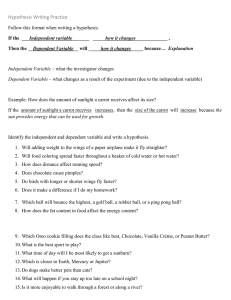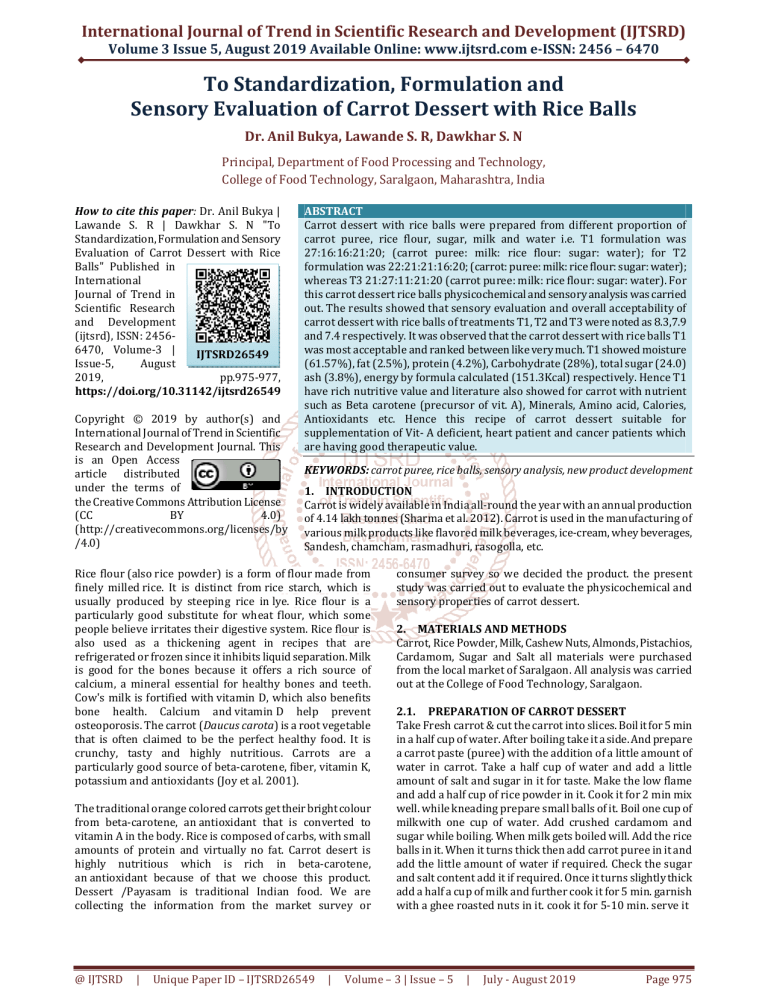
International Journal of Trend in Scientific Research and Development (IJTSRD)
Volume 3 Issue 5, August 2019 Available Online: www.ijtsrd.com e-ISSN: 2456 – 6470
To Standardization, Formulation and
Sensory Evaluation of Carrot Dessert with Rice Balls
Dr. Anil Bukya, Lawande S. R, Dawkhar S. N
Principal, Department of Food Processing and Technology,
College of Food Technology, Saralgaon, Maharashtra, India
How to cite this paper: Dr. Anil Bukya |
Lawande S. R | Dawkhar S. N "To
Standardization, Formulation and Sensory
Evaluation of Carrot Dessert with Rice
Balls" Published in
International
Journal of Trend in
Scientific Research
and Development
(ijtsrd), ISSN: 24566470, Volume-3 |
IJTSRD26549
Issue-5,
August
2019,
pp.975-977,
https://doi.org/10.31142/ijtsrd26549
Copyright © 2019 by author(s) and
International Journal of Trend in Scientific
Research and Development Journal. This
is an Open Access
article distributed
under the terms of
the Creative Commons Attribution License
(CC
BY
4.0)
(http://creativecommons.org/licenses/by
/4.0)
ABSTRACT
Carrot dessert with rice balls were prepared from different proportion of
carrot puree, rice flour, sugar, milk and water i.e. T1 formulation was
27:16:16:21:20; (carrot puree: milk: rice flour: sugar: water); for T2
formulation was 22:21:21:16:20; (carrot: puree: milk: rice flour: sugar: water);
whereas T3 21:27:11:21:20 (carrot puree: milk: rice flour: sugar: water). For
this carrot dessert rice balls physicochemical and sensory analysis was carried
out. The results showed that sensory evaluation and overall acceptability of
carrot dessert with rice balls of treatments T1, T2 and T3 were noted as 8.3,7.9
and 7.4 respectively. It was observed that the carrot dessert with rice balls T1
was most acceptable and ranked between like very much. T1 showed moisture
(61.57%), fat (2.5%), protein (4.2%), Carbohydrate (28%), total sugar (24.0)
ash (3.8%), energy by formula calculated (151.3Kcal) respectively. Hence T1
have rich nutritive value and literature also showed for carrot with nutrient
such as Beta carotene (precursor of vit. A), Minerals, Amino acid, Calories,
Antioxidants etc. Hence this recipe of carrot dessert suitable for
supplementation of Vit- A deficient, heart patient and cancer patients which
are having good therapeutic value.
KEYWORDS: carrot puree, rice balls, sensory analysis, new product development
1. INTRODUCTION
Carrot is widely available in India all-round the year with an annual production
of 4.14 lakh tonnes (Sharma et al. 2012). Carrot is used in the manufacturing of
various milk products like flavored milk beverages, ice-cream, whey beverages,
Sandesh, chamcham, rasmadhuri, rasogolla, etc.
Rice flour (also rice powder) is a form of flour made from
finely milled rice. It is distinct from rice starch, which is
usually produced by steeping rice in lye. Rice flour is a
particularly good substitute for wheat flour, which some
people believe irritates their digestive system. Rice flour is
also used as a thickening agent in recipes that are
refrigerated or frozen since it inhibits liquid separation. Milk
is good for the bones because it offers a rich source of
calcium, a mineral essential for healthy bones and teeth.
Cow's milk is fortified with vitamin D, which also benefits
bone health. Calcium and vitamin D help prevent
osteoporosis. The carrot (Daucus carota) is a root vegetable
that is often claimed to be the perfect healthy food. It is
crunchy, tasty and highly nutritious. Carrots are a
particularly good source of beta-carotene, fiber, vitamin K,
potassium and antioxidants (Joy et al. 2001).
The traditional orange colored carrots get their bright colour
from beta-carotene, an antioxidant that is converted to
vitamin A in the body. Rice is composed of carbs, with small
amounts of protein and virtually no fat. Carrot desert is
highly nutritious which is rich in beta-carotene,
an antioxidant because of that we choose this product.
Dessert /Payasam is traditional Indian food. We are
collecting the information from the market survey or
@ IJTSRD
|
Unique Paper ID – IJTSRD26549
|
consumer survey so we decided the product. the present
study was carried out to evaluate the physicochemical and
sensory properties of carrot dessert.
2. MATERIALS AND METHODS
Carrot, Rice Powder, Milk, Cashew Nuts, Almonds, Pistachios,
Cardamom, Sugar and Salt all materials were purchased
from the local market of Saralgaon. All analysis was carried
out at the College of Food Technology, Saralgaon.
2.1. PREPARATION OF CARROT DESSERT
Take Fresh carrot & cut the carrot into slices. Boil it for 5 min
in a half cup of water. After boiling take it a side. And prepare
a carrot paste (puree) with the addition of a little amount of
water in carrot. Take a half cup of water and add a little
amount of salt and sugar in it for taste. Make the low flame
and add a half cup of rice powder in it. Cook it for 2 min mix
well. while kneading prepare small balls of it. Boil one cup of
milkwith one cup of water. Add crushed cardamom and
sugar while boiling. When milk gets boiled will. Add the rice
balls in it. When it turns thick then add carrot puree in it and
add the little amount of water if required. Check the sugar
and salt content add it if required. Once it turns slightly thick
add a half a cup of milk and further cook it for 5 min. garnish
with a ghee roasted nuts in it. cook it for 5-10 min. serve it
Volume – 3 | Issue – 5
|
July - August 2019
Page 975
International Journal of Trend in Scientific Research and Development (IJTSRD) @ www.ijtsrd.com eISSN: 2456-6470
Flowchart1: Preparation of Carrot Dessert
Table1: Recipe standardization of Preparation of carrot dessert (per 100 g)
INGREDIENTS CONTROL T1 T2 T3
Carrot puree (g)
24 26 30
Sugar (g)
20
20 25 20
Milk (ml)
30
20 20 20
Water (ml)
20
20 15 15
Rice balls (g)
20
10 10 10
Cardamom (g)
4
1
1
1
Dry fruits (g)
5
4
2
3
Salt (g)
1
1
1
1
2.2. Proximate Composition and Quality parameters of the prepared Carrot Dessert
Protein, fat, crude fiber, ash, carbohydrate (difference method), Moisture content was done AOAC method (2002).
2.3. Organoleptic Evaluation of Carrot Dessert
Prepared carrot dessert was evaluated for organoleptic characteristics like colour, flavor, taste and overall acceptability by a
panel of semi-trained judges, comprised of graduate students and academic staff members of College of Food Technology,
Saralgaon, Samples were scored based on a nine-point hedonic scale. Judges were asked to rate the product on 9 points
Hedonic scale with corresponding descriptive terms ranging from 9 ‘like extremely’ to ‘dislike extremely’.
3. RESULTS AND DISCUSSION
3.1. Proximate composition
Proximate composition of T1 treated sample showed that Fat (2.5 %), protein (4.2%), Ash (3.8%), moisture (61.57%),
carbohydrates (28.0 %), Energy (151.3 kcal) in the range were observed.
@ IJTSRD
|
Unique Paper ID – IJTSRD26549
|
Volume – 3 | Issue – 5
|
July - August 2019
Page 976
International Journal of Trend in Scientific Research and Development (IJTSRD) @ www.ijtsrd.com eISSN: 2456-6470
Table2: Proximate composition of Carrot Dessert T1
Parameter
Value per 100 gram
Moisture
61.57 ±1.21
Ash
3.8 ± 0.53
Energy (Kcal)
151.3 ± 2.82
Carbohydrates
28.0 ± 3.25
Protein
4.2 ± 0.58
Total sugar
24.0 ± 2.42
Fat
2.5 ± 0.42
Mean ± SD values were presented
3.2.
Sensory Organoleptic Evaluation
Table3: Sensory Evaluation of Carrot dessert
Parameter/sample
T0
T1
T2
T3
Color
8 ± 0.94 8.4 ± 0.69 7.9 ± 0.52 7.4 ± 0.51
Taste
8.1 ± 0.73 8.5 ± 0.52 7.5 ± 0.70 7.4 ± 0.69
Flavor
7.9 ± 0.87 8.4 ± 0.69 7.5 ± 0.52 7.3 ± 0.48
Consistency
7.7 ± 0.67 8.1 ± 0.56 7.2 ± 0.63
Overall acceptability 8 ± 0.81 8.3 ± 0.82 7.4 ± 0.51
Mean ± SD values were presented
7.5 ± 0.70
7.5 ± 0.52
CONTROL- control sample is a simple kheer
T1- with the addition of carrot puree
T2- the amount of carrot puree and sugar is increased
T3- with the extra addition of carrot puree and sugar
This table shows that score for samples T1 recorded highest. This score for parameters like colour (8.4 ± 0.69) taste (8.5 ± 0.52)
flavor (8.4 ± 0.69) consistency (8.1 ± 0.56) and overall acceptability (8.3 ± 0.82) was found. The sample T1 was organoleptically
better than other dessert samples. The lowest score showed for T3 sample in color, taste, and flavor.
CONCLUSION
The superior quality of carrot fortified with rice ball dessert
can be prepared by the addition of 24 parts of carrot s and
20 g of sugar with 20 parts of milk showed the best sensory
evaluation and quality. The development of vegetable carrot
dessert incorporated with rice balls going to show good
market demand in Indian in the future for the vegetarian
population in any functions and festivals when exploitation
is carried out.
REFERENCES
[1] AOAC, Official Methods of Analysis of AOAC
International, Association of Official Analytical
Chemists, Arlington, 17th edition, 2002.
[2] Salunke et.al 2015 Physicochemical Analysis and
Sensory Evaluation of Kheer Fortified with Carrot
Shreds Journal of Animal Research: v.5 n.4, p. 849-853.
December 2015
@ IJTSRD
|
Unique Paper ID – IJTSRD26549
|
[3] Chaudhary, A. 1989. Standardization of the method for
production and preservation of Kheer, M.Sc. Thesis.,
National Dairy Research Institute, Karnal. India.
[4] Shahmihammadi M., Javadi, M., Nassiri-Asl, M., (2016)
An Overview on the Effects of Sodium Benzoate as a
Preservative in Food Products Biotech Health Sci.
Biotech health science in the press, e35084.
[5] Sharma, K.D., Karki, S., Thakur, N.S. and Attri, S. 2012.
Chemical composition, functional properties and
processing of carrot - a review. J. Food Sci. Tech., 49(1):
22-32.
[6] Joy, P.P., Thomas, J., Mathew, S. and Skaria, B.P. 2001.
Medicinal plants. In: Tropical Horticulture, (Eds.): Bose,
T.K., J. Kabir, P. Das and P.P. Joy. Naya Prokash,
Calcutta, 2: 449-632.
Volume – 3 | Issue – 5
|
July - August 2019
Page 977

